With my backpack’s sternum strap fastened snugly across my chest, I speed-walked down
León’s main avenue at 6:45 in the morning. Although the city still slept, darkness had given way to dawn—albeit a gray dawn, as rain was forecast for the region. I hopped on a glossy-white
Regional Express train and had only biking enthusiasts for seatmates—and their bikes. Half an hour passed by and the rain and the train picked up speed. Soon the ruddy twin towers of
Astorga’s cathedral came into view as we went through a curve: decorated blocks topped with pointy, slate pyramids.
I left the train station at the bottom of the hill and set off to find breakfast on this drizzly, quiet Saturday morning. Almost no one was out and about, not even party-till-the-sun-comes-up types—but to be fair, this town’s population barely reaches 11,000. Rain pitter-pattered on my polyester backpack cover, my meager umbrella, and my canvas shoes. I arrived at Astorga’s grand square only to find it deserted at eight in the morning. Avoiding puddles with little success, I leaned back, umbrella still open, and sighed at the cathedral’s locked, wooden doors.
In an empty bar nearby, I woke up over a warm
café con leche and toasted bread served with olive oil and half a whole tomato, an awkward departure from the traditional grated pulp. A gregarious coterie of nurses came in and gave the café some atmospheric caffeine to accompany our coffees. They left for work after scarfing down a pastry here, a shot of espresso there, but the rain continued to fall.
It was almost nine, so I scooped up the change from paying for breakfast, suited up my backpack, and decided to check out the cathedral.
Feel refreshed at the cathedral
It seemed a bit overkill for a small
pueblo like Astorga to have a cathedral, but that hasn’t stopped church authorities in Spain before (see:
Albarracin,
Baeza, etc.). The town’s bishopric, though, dates back to the 300s, so with age comes prestige. The current cathedral’s westwork showed off bell towers so very typical of Spain’s
meseta or central plateau: tall, square towers whose slate-shingled roofs in the form of geometric pyramids are capped with belfries that take on the shape of diamond-shaped spears. The cathedral’s interior was decidedly Late Gothic, styled more with soaring walls and fancy ceiling tracery in mind than with maximizing stained glass, as in
the cathedral of León.
After slipping past heavy, ancient doors and making sure the wind didn’t slam them shut, I entered into a sanctuary in the true meaning of the word: a peaceful place that truly felt holy. As the cathedral had just opened, there were no other tourists shuffling their feet from side-chapel to side-chapel or grannies whispering prayers in the pews; I was alone with these towering Gothic arches and the soft
basso continuo of the endless rain.
It wasn’t long before the church’s caretaker struck up a conversation with me, asking if I was a pilgrim and gesturing at my backpack’s rain cover. Other weary, soaked pilgrims along the Camino de Santiago had begun to trickle in and take refuge here, but I was not among them, I replied. We got to talking about how Astorga’s cathedral, along with those in
Segovia and Salamanca, are some of the youngest Gothic cathedrals anywhere in Europe; apparently Spain just couldn’t let go of the Gothic when the Renaissance came into vogue.
Walking past the mammoth columns illuminated in magenta, mint, and goldenrod hues, the caretaker took me to the front of the church and pointed out the ornate, realistic wooden altarpiece, designed by Gaspar de Becerra—who happened to be a student of Michelangelo. The caretaker eventually had to leave to continue preparing things for Mass, but I was glad to humor him on this boring Saturday morning (and learn a thing or two about this interesting building).
Explore the cathedral museum
The
Museo Catedralicio would finally open an hour after the cathedral did, so after twiddling my thumbs, wandering around the aisles, and probably ticking off some old ladies with my camera shutter noises, I was first in line to buy tickets, perhaps following the cashier in a little over eagerly as she unlocked the door. Compared to other “sacred art” museums I’ve been to in Spain, this one really took the cake with its variety of pieces that ranged from Romanesque sculptures of the Madonna and Child to 1800s-era bishop robes and even a painting that depicts the conversion of the pagan Queen Lupa (see
my post on Pico Sacro for more details).
Appreciate Gaudí’s architecture at the Episcopal Palace
Back outdoors, I meandered across the plaza to the next-door
Palacio Episcopal, built by
Antoni Gaudí at the request of his friend Joan Baptista Grau i Vallespinós. Although Grau was at the time the bishop of Astorga, both were both born in the Catalan city of Reus, which explains why Gaudí, who almost exclusively worked within his native Catalunya, would come out west to lonely León. The previous episcopal palace had burned down, so Gaudí accepted the commission to rebuild it—and rebuild it he did in his unmistakable style. Like his
Casa de los Botines in the provincial capital of León, Gaudí’s Episcopal Palace is also a granite-and-slate, Neo-Gothic structure with round turrets, swooping buttresses, and triplets of narrow windows.
It was never used for its intended purpose as the bishop’s residence. Today, this extravagant building houses the
Museo de los Caminos, a museum dedicated to the
Camino de Santiago pilgrimage. While a similar museum in Santiago de Compostela gives a better look into the actual pilgrimage, Astorga’s showed off Roman artifacts, religious statues of St. James, and some surprisingly compelling paintings by local artists.
I really enjoyed getting to stroll through the dining room, which sat on top of the swooping owl-eye entrance. The sets of three oddly-humanoid windows seemed to say “Father, Son, and Holy Spirit,” and let in a muted, tender light to the bishop’s refectory. The
private chapel contrasted with this room on the opposite side of the palace: great pointed arches raised up embellished walls to even higher stained glass—a very sparkly combination.
Astorga’s episcopal palace is one of three works by Gaudí done outside of Catalunya—which made seeing this unique building even more special.
Descend into the Roman Museum
Although I had trouble getting around the corner from the main plaza to find this museum, Astorga’s
Museo Romano was a nice little presentation of the town’s Roman heritage.
Founded as
Asturica Augusta, this legion camp-turned-city was even the capital of the
Conventus Asturicensis, a judicial subdivision of the northwestern Roman province of
Gallaecia. One half of the modern museum took me underground to the
ergástula: a barrel-vaulted foundation used to reinforce the heavy main temple in ancient Astorga’s forum. That Roman arch sure found itself into everything, didn’t it?
A few gravestones here, some coins there, and a really bright bit of frescoed wall were the only highlights in this rather humble collection. Still, I thought it was great that Astorga’s Roman heritage has been preserved and put on display.
Treat your sweet tooth at the Chocolate Museum
I saved the best for last. The
Museo del Chocolate, despite operating out of a converted house in a narrow alleyway, couldn’t hide from me. Decorated with 19th century-era artifacts from when Astorga’s main industry was chocolate, a small lobby opened up into a tasting room and a video room. Included with the price of admission was a showing of a VHS-quality recording of how chocolate was originally produced: slowly roasting chocolate in a continually-rolled barrel, shelling all the beans, extracting the cacao liquor by mashing the beans on a
metate, and finally mixing the liquor/paste with a few other ingredients in a great vat to create molten chocolate. The “old-fashioned way” was a LOT of work, and at the end of the video they showed how industrial-era machines made things so much easier.
At the end of the visit, I got to taste a variety of local chocolates, including white, milk, dark, and a three-layered version. I’m still kicking myself for only picking up a single bar of dark chocolate because—I’m not kidding—it was the best dark chocolate I’ve ever tasted in my life: not too bitter and just sweet enough to let that rich cacao flavor fill your mouth.
With a brown cardboard bag from the chocolate museum in tow, I left the museum—and it had finally stopped raining.
Which of these places from my daytrip to Astorga most interests you? Tell me in the comments section below!













